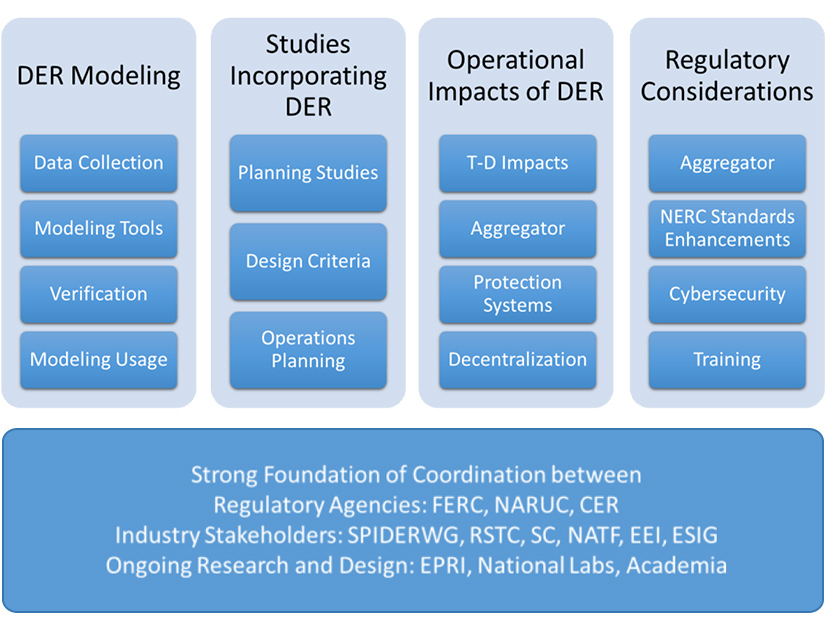In a new report released this week, NERC warned that the bulk power system is in the middle of a major transformation because of the spread of distributed energy resources, creating a learning curve for which stakeholders are in danger of falling behind.
In the Distributed Energy Resource Strategy document published Tuesday, NERC said the ongoing “influx of DERs presents potential benefits as well as challenges for grid reliability, resilience and flexibility,” noting that the cumulative capacity of distributed solar facilities is set to rise from about 25,000 MW last year to more than 60,000 MW by 2031. The organization said its goal in presenting the report is to outline “current and future strategic actions” to ensure the grid can be operated reliably as these resources’ share of generation grows.
The new report is similar to a document NERC produced in September, detailing the organization’s risk mitigation strategy for inverter-based resources, a class of generators that includes large solar and wind farms. (See NERC Outlines IBR Risk Mitigation Strategy.)
NERC’s System Planning Impacts from DERs (SPIDER) Working Group has played a major role in the ERO Enterprise’s efforts to adapt the grid for the impact of DERs. The group defines DERs as “any source of electric power located on the distribution system,” which refers to electrical facilities located behind a transmission-distribution transformer that serve multiple end-use customers. In practice, this most often refers to rooftop solar panels and storage technology at businesses or homes.
DERs are attractive for end users because they offer the opportunity to reduce electric bills and provide some chance of operating independently in the event of a service outage; they can also lighten the burden on utilities during periods of high demand, decreasing the risk that interventions like load shedding will be needed. In a report issued in August, SPIDER noted that because they sit behind the meter, DERs have traditionally been viewed as a part of the distribution system only, with little or no impact on the broader bulk power system. (See NERC’s SPIDER Group Warns of Modeling Difficulties for DERs.)
However, the new report warned that the installation of these resources on the grid has proceeded much faster than BPS planners’ understanding of their potential impacts to reliability. NERC’s DER risk mitigation strategy is primarily designed to help stakeholders share their knowledge and push forward their collective expertise on the subject.
Core Tenets Underlying Strategy
The strategy comprises four core tenets. First is DER modeling; according to the report, SPIDER’s interactions with industry experts have “identified that a lack of DER modeling information, tools and established planning practices is limiting [utilities’] abilities to accurately incorporate DER models into planning assessments.” NERC said the group’s efforts in this category will primarily focus on industry guidance, but they will also require changes to reliability standards that relate to modeling in order to ensure planners have the appropriate DER data for modeling purposes.
Another tenet is to ensure that future studies of BPS reliability incorporate the effects of DERs in aspects including the pre-disturbance base case setup, selection of reliable contingencies and analysis of how aggregate DERs will respond to large-scale grid disturbances. SPIDER is currently working to develop a reliability guideline to encourage entities to account for DER growth in their studies; NERC is updating its standards to “ensure … requirements are adequate and clear on how to model, study and assess” the impact of DERs on planning assessments, with further standards updates likely to come in the future.
NERC is also studying the risks associated with the next core tenet, the operational impacts of DER — particularly as it relates to decentralization and the shift of significant amounts of generation to the distribution system. SPIDER is also developing a white paper focused on coordination between transmission and distribution entities to improve BPS reliability.
Finally, the last tenet of the strategy is the contribution of regulatory bodies, particularly FERC, to the conversation. NERC pointed to FERC’s Order 2222, which required RTOs and ISOs to open their markets to DER aggregations, as introducing “unique operational benefits and challenges for grid planners and operators” and showing that other stakeholders will not wait for the ERO Enterprise to take the lead on DERs. The report observed that further regulatory action may target other areas of the ERO’s purview, such as reliability standards, training and education, and cybersecurity.



